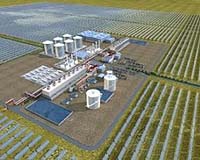 |
Payerne, Switzerland (AFP) July 5, 2010 When the Solar Impulse airplane took off on its pioneering round the clock flight Wednesday, the solar panels spread over a wing similar in size to that of an Airbus generated a tiny fraction of an airliner's power. Each of the prototype's four solar-powered electric propellor motors produces barely more thrust than the flimsy petrol engine that helped the Wright Brothers make history with the world's first powered flight in 1903. "We're rather far from commercial aviation," acknowledged Pascal Vuilliomenet of the Swiss federal institute of technology in Lausanne (EPFL), a technical university that is heavily involved in the solar powered aircraft. Despite its limitations, the Swiss venture is attracting some of the best engineering brains around, industrial support, cutting-edge aviation technology and electronics, as well as the experience of an ex-astronaut, a former NASA test pilot and ballooning adventurers. The 70-strong team are driven by the belief that a historic night flight fuelled by stored energy from the sun will be the first step in proving that more widespread use of solar energy is feasible today, not simply in aviation. Team chief Bertrand Piccard believes that if an aircraft can fly day and night without fuel, no one could challenge the wider value of such technology in the household or at work. "Solar Impulse is as much a message as an airplane," said Piccard Wednesday. Flight control chief and former space shuttle astronaut Claude Nicollier told AFP that he does not see airliners running on solar energy in the foreseeable future. "One of the engines of the Airbus A380 has about 25,000 kilowatts of power, here we have 6 kw (10 horsepower) on average with a huge set of solar panels on a huge wing, so it's orders of magnitude of difference," he explained. Nicollier believes minor electronic equipment onboard airliners might become solar powered, but that the future for jumbo jet engines lies with new generation biofuels and subsequently hydrogen fuel cells. His colleagues argue that the key to their prototype lies in highlighting and developing the technology: the solar panels, the batteries and the motors, as well as the ultra lightweight construction. Vuilliomenet, the link man between the EPFL and Solar Impulse, said technological spin-offs from the components developed and refined with the prototype and its successor could reach the car industry. Anil Sethi, chief executive of advanced "thin film" solar panel firm Flisom, said projects like Solar Impulse can feed into space flight or ground-borne transport. "You'll never have flight powered by solar energy from Zurich to New York in a reasonable timeframe," added Sethi, although he did not rule out solar powered light aircraft for enthusiasts. The single seater Solar Impulse prototype carries 12,000 solar cells across the wingspan of an Airbus A340 (63.4 metres) and weighs as much as an average family car (1,600 kg). The 400 kg of lithium-polymer batteries have just enough capacity to store energy for an eight hour flight through pitch darkness in perfect conditions. Piccard said the solar cells have gained in efficiency and become twice as thin in the seven years since the project was launched. But he tacitly admits that technological limits have scaled back thoughts of a non-stop, solar-powered circumnavigation of the globe, leaving the crew to dream of a series of five day hops around the world. "To make it non stop with a two seater we'd need a leap in technology to another level, and that's not in sight despite billions spent (worldwide) on research," said Piccard. "The aim for industry research on batteries and solar panels now is to move from a linear growth in performance to exponential growth," he added.
Share This Article With Planet Earth
Related Links All About Solar Energy at SolarDaily.com
 Conditional Federal Loan Guarantees For Abengoa Solar
Conditional Federal Loan Guarantees For Abengoa SolarWashington DC (SPX) Jul 07, 2010 President Obama has announced in his weekly video address that DOE has offered a conditional commitment for a $1.45 billion loan guarantee to Abengoa Solar, Inc. The loan will support the construction and start-up of Solana, a 250 net megawatt (MW) concentrating solar power (CSP) plant in Arizona. "After years of watching companies build things and create jobs overseas, it's good news that ... read more |
|
| The content herein, unless otherwise known to be public domain, are Copyright 1995-2010 - SpaceDaily. AFP and UPI Wire Stories are copyright Agence France-Presse and United Press International. ESA Portal Reports are copyright European Space Agency. All NASA sourced material is public domain. Additional copyrights may apply in whole or part to other bona fide parties. Advertising does not imply endorsement,agreement or approval of any opinions, statements or information provided by SpaceDaily on any Web page published or hosted by SpaceDaily. Privacy Statement |